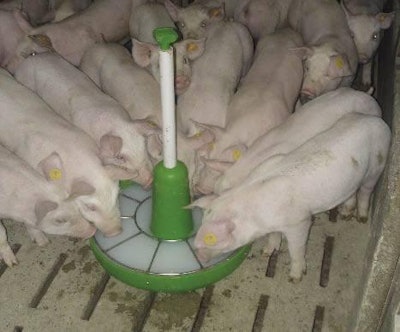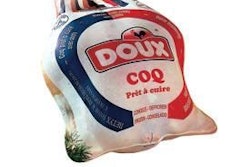
When you seek to develop a vaccine that protects against a major disease, you do not consider only the ease of application or the complexity of trials in a laboratory. You want to know how it will perform in practice, whether it suits modern intensive production and how it fits the new rules of animal welfare. Considerations of this type are evolving today into selection criteria favouring oral vaccines.
Advantages of oral vaccine administration in pig production begin with the elimination of stress for the animal (the pigs are vaccinated by drinking water) and the reduction of effort, costs and time for the farm personnel compared with the task of giving numerous individual mass vaccinations, which usually need to be repeated at least once. Without injection, you take away the multi-use needle as a possible transmitter of infections such as the PRRS virus and you also eliminate possible local reactions in the meat. What is more, the most commonly used adjuvants in injectable vaccines can occasionally cause persistent necrotising lesions in the muscles of pigs, and recent research has shown certain adjuvants may be responsible for the immune-potentiation of latent PCV2 infections.
There is likely to be a considerable improvement of the wellbeing of the pigs by vaccinating them orally. With a live oral vaccine you vaccinate them only once and you avoid injections entirely, with no sacrifice of compliance on farms. Two independent surveys demonstrated recently that when the vaccine is administered via drinking water, the proportion of pigs that really drink it is no different to the compliance of vaccine administration via common inoculation techniques (some animals are injected twice and others not at all in each of the injection phases). In these trials, oral vaccination was an effective method for preventing the painful and sometimes fatal disease, ileitis, when the suggested period of 4 hours for oral uptake was employed.
Candidate diseases: Vaccination via water is becoming an option for several diseases in pig production. Commercial oral vaccines are available for 3 diseases: erysipelas, salmonellosis and ileitis. All these are bacterial diseases that affect pigs post-weaning. Research and development groups connected to major vaccine companies are now also working with isolates of Mycoplasma hyopneumoniae, Haemophilus parasuis and Actinobaccilis pleuropneumoniae which might be appropriate also for oral administration in the water. Attenuated strains of Mycoplasma and Haemophilus that fulfil the requirements for oral vaccines are already used widely in poultry production.
Diseases caused by parasites are not very common in the post-weaning period in modern pork systems, whereas viral infections are often best controlled by injectable vaccines. It is therefore likely that the focus of R&D for oral vaccines will be on bacterial isolates.
Criteria for oral vaccines: Above all, the production of a potential oral vaccine depends on finding an adequate attenuated strain of the causative agent, which can be cultivated in the laboratory and which grows well in larger vaccine facilities. Furthermore, it needs to have the majority of the virulence factors that control the infectivity of the agent, meaning it has to grow in the host to a certain extent so the host recognises the causal agent and can develop an appropriate immune response. Nevertheless, it must lack those virulence factors that are necessary for a full clinical expression of the disease.
A separate approach is to add the likely virulence genes of the bacteria into a live E. coli or Salmonella vector strain, which produces these protein virulence factors as a so-called subunit vaccine. Successful use of this approach has been demonstrated for a few small viruses, such as Aujeszky/pseudorabies, but not for bacteria. This is probably because most pathogenic bacteria have dozens of virulence factors that cannot be integrated easily into a vaccine vector, added to the fact that the actual protein produced by the vector often does not fully resemble the protein produced by the original bacteria.
Application method: Oral vaccines need to mimic the pathogenesis of the original field isolate in order to induce a long-lasting immunity after uptake. Therefore they need to arrive at their target host cell without loss of immunogenicity. Being a live attenuated vaccine, this is especially true for the ileitis vaccine Enterisol ileitis, which is now registered for the European market. Its application requires a 7-day period free of any ileitis-active microbial substances (composed of 3 days before vaccination, the day of application and another 3 days afterwards). This means no antibiotics in the feed or water and no growth-promoting antimicrobial substances in feeds. Disinfecting agents such as chloride, chloride-derivates and quaternary-ammonium compounds are not allowed in the water at the time of vaccination.
All vaccines must be given well before the actual disease will strike, to allow plenty of time for host immunity to develop. After ileitis vaccination, a period of 3 weeks is needed for the pigs to acquire immunity that will protect them against a field challenge. Considering that seroconversion is normally seen at around 3 weeks after a challenge, this implies that vaccination needs to take place at least 6 weeks before seroconversion is detected in a herd.
There are 2 types of ileitis in many herds in Europe. One is the acute haemorrhagic form seen in older finisher and breeder pigs, for which vaccination is relatively simple because of the age at which the animals will be affected. However, with the other form where the infection is common in grower stages the correct timing of ileitis vaccination is around 3 weeks of age.
Measuring efficacy: Return on investment is the main driver in a production unit regarding the decision to start vaccinating against a disease. This can take account of traits including average daily weight gain, reduced attrition, increased uniformity or a reduction of clinical symptoms, all in relation to the costs of vaccine usage.
To take the example of Enterisol ileitis, it has been shown to be efficacious by field studies in Belgium, Denmark, Germany, Greece, Switzerland, Mexico, USA, Japan and Australia. Results for grower pigs show that vaccinated animals will be heavier at the end of the nursery period and are more uniform when they enter the grower unit. This benefit extends itself in the finishing section by showing a higher average gain of up to 30 grams per day and a significant reduction of the number of lightweight animals in a group of slaughtered pigs. Detailed measurements of the return on investment across numerous farms have varied from 2.5:1 to 5:1. Many units start by using the vaccine for their valuable breeder pigs in order to prevent the costly losses of acute ileitis cases and follow that with oral vaccination of the grower pigs.
So there is firm evidence that oral vaccination against bacterial diseases has proven to be an efficacious, labour-reducing and stress-free alternative to injectable vaccines or antibiotic treatments. For the pig industry this is a future option that will soon become a preferred programme for vaccine-derived protection against many diseases.















